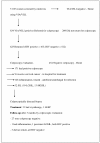Evaluation of 'see-see and treat' strategy and role of HIV on cervical cancer prevention in Uganda
- PMID: 20459733
- PMCID: PMC2882355
- DOI: 10.1186/1742-4755-7-4
Evaluation of 'see-see and treat' strategy and role of HIV on cervical cancer prevention in Uganda
Abstract
Background: There is scant information on whether Human Immunodeficiency Virus (HIV) seropositivity has an influence on the outcome of treatment of precancerous cervical lesions using cryotherapy. We studied the prevalence of cervical abnormalities detectable by visual inspection and cervical lesions diagnosed by colposcopy according to HIV serostatus and described the outcomes of cryotherapy treatment.
Methods: Trained nurses examined women not previously screened for cervical cancer using visual inspection with acetic acid (VIA) and Lugol's iodine (VILI) in two family planning/post natal clinics in Kampala, Uganda, from February 2007 to August 2008. Women with abnormal visual inspection findings were referred for colposcopic evaluation and HIV testing. Women with precancerous cervical lesions detected at colposcopy were treated mainly by cryotherapy, and were evaluated for treatment outcome after 3 months by a second colposcopy.
Results: Of the 5 105 women screened, 834 presented a positive screening test and were referred for colposcopy. Of these 625 (75%) returned for the colposcopic evaluation and were tested for HIV. For the 608 (97.5%) women in the age range 20-60 years, colposcopy revealed 169 women with cervical lesions: 128 had inflammation, 19 had low grade squamous intraepithelial lesion (LGSIL), 13 had high grade squamous intraepithelial lesion (HGSIL), 9 had invasive cervical cancer and 2 had inconclusive findings. Detection rates per 1 000 women screened were higher among the older women (41-60 years) compared to women aged 20-40 years. They were accordingly 55% and 20% for inflammation, 10% and 2% for LGSIL, 5% and 2% for HGSIL, 6% and 1% for invasive cervical cancer.Of the 608 women, 103 (16%) were HIV positive. HIV positivity was associated with higher likelihood of inflammation (RR = 1.7; 95% CI: 1.2-2.4).
Conclusions: Detection rates were higher among older women 41-60 years. Visual inspection of the cervix uteri with acetic acid (VIA) and Lugol's iodine (VILI) used as a sole method for cervical cancer screening would entail significant false positive results. HIV seropositivity was associated with a higher prevalence of inflammatory cervical lesions. In view of the small numbers and the relatively short follow up time of 3 months, we could not make an emphatic conclusion about the effect of HIV serostatus on cryotherapy treatment outcome.
Similar articles
-
Visual techniques for cervical cancer screening in Colombia.Biomedica. 2019 Mar 31;39(1):65-74. doi: 10.7705/biomedica.v39i1.4007. Biomedica. 2019. PMID: 31021548 English, Spanish.
-
Evaluation of visual inspection with acetic acid (VIA), Lugol's iodine (VILI), cervical cytology and HPV testing as cervical screening tools in Latin America. This report refers to partial results from the LAMS (Latin AMerican Screening) study.J Med Screen. 2005;12(3):142-9. doi: 10.1258/0969141054855328. J Med Screen. 2005. PMID: 16156945
-
Diagnostic accuracy of cervical cancer screening and screening-triage strategies among women living with HIV-1 in Burkina Faso and South Africa: A cohort study.PLoS Med. 2021 Mar 4;18(3):e1003528. doi: 10.1371/journal.pmed.1003528. eCollection 2021 Mar. PLoS Med. 2021. PMID: 33661957 Free PMC article.
-
Prevention of cervical cancer in HIV-seropositive women from developing countries through cervical cancer screening: a systematic review.Syst Rev. 2018 Nov 17;7(1):198. doi: 10.1186/s13643-018-0874-7. Syst Rev. 2018. PMID: 30447695 Free PMC article.
-
Use of Smartphones for the Detection of Uterine Cervical Cancer: A Systematic Review.Cancers (Basel). 2021 Dec 1;13(23):6047. doi: 10.3390/cancers13236047. Cancers (Basel). 2021. PMID: 34885157 Free PMC article. Review.
Cited by
-
Implementation and Operational Research: Age Distribution and Determinants of Invasive Cervical Cancer in a "Screen-and-Treat" Program Integrated With HIV/AIDS Care in Zambia.J Acquir Immune Defic Syndr. 2015 Sep 1;70(1):e20-6. doi: 10.1097/QAI.0000000000000685. J Acquir Immune Defic Syndr. 2015. PMID: 26322673 Free PMC article.
-
Sexual and reproductive health and human rights of women living with HIV.J Int AIDS Soc. 2015 Dec 1;18(6Suppl 5):20834. doi: 10.7448/IAS.18.6.20834. eCollection 2015. J Int AIDS Soc. 2015. PMID: 28326129 Free PMC article. No abstract available.
-
Implementing a Fee-for-Service Cervical Cancer Screening and Treatment Program in Cameroon: Challenges and Opportunities.Oncologist. 2017 Jul;22(7):850-859. doi: 10.1634/theoncologist.2016-0383. Epub 2017 May 23. Oncologist. 2017. PMID: 28536303 Free PMC article.
-
Public health approach to prevent cervical cancer in HIV-infected women in Kenya: Issues to consider in the design of prevention programs.Gynecol Oncol Rep. 2017 Oct 16;22:82-88. doi: 10.1016/j.gore.2017.10.002. eCollection 2017 Nov. Gynecol Oncol Rep. 2017. PMID: 29159260 Free PMC article. Review.
-
Willingness and acceptability of cervical cancer screening among women living with HIV/AIDS in Addis Ababa, Ethiopia: a cross sectional study.Gynecol Oncol Res Pract. 2015 Sep 18;2:6. doi: 10.1186/s40661-015-0012-3. eCollection 2015. Gynecol Oncol Res Pract. 2015. PMID: 27231566 Free PMC article.
References
-
- International Agency for Research on Cancer. Uganda. In: Parkin DM, Ferlay J, Hamdi-Cherif M, Sitas F, Thomas JO, Wabinga HR, Whelan SL, editor. Cancer in Africa: epidemiology and prevention. Lyon: IARC Press; 2003. pp. 167–179.
LinkOut - more resources
Full Text Sources


